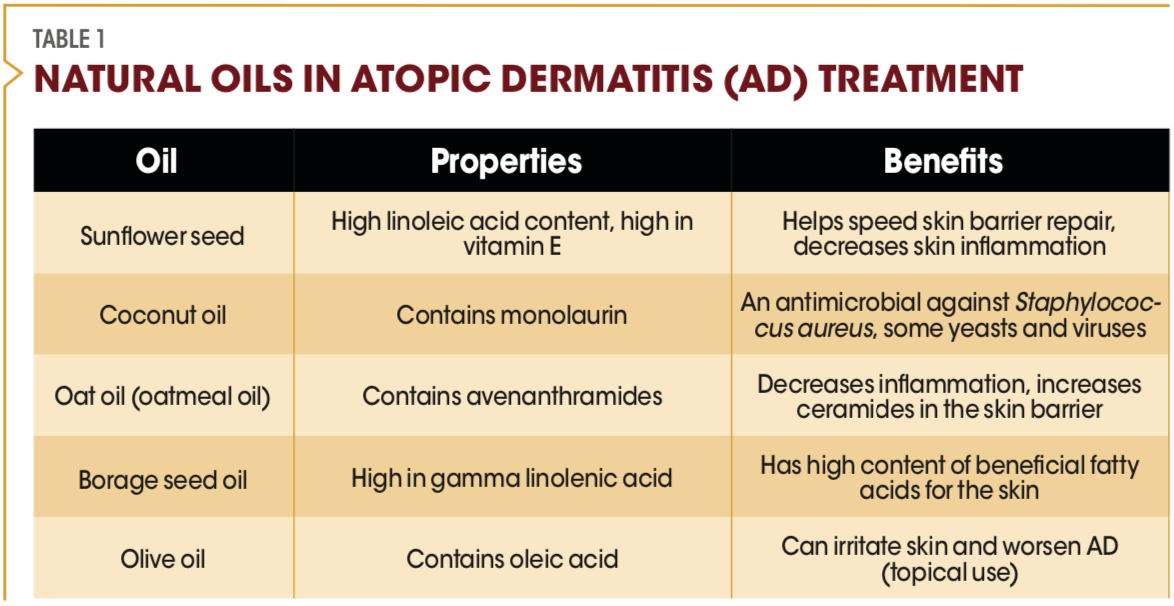- Acne
- Actinic Keratosis
- Aesthetics
- Alopecia
- Atopic Dermatitis
- Buy-and-Bill
- COVID-19
- Case-Based Roundtable
- Chronic Hand Eczema
- Drug Watch
- Eczema
- General Dermatology
- Hidradenitis Suppurativa
- Melasma
- NP and PA
- Pediatric Dermatology
- Pigmentary Disorders
- Practice Management
- Precision Medicine and Biologics
- Prurigo Nodularis
- Psoriasis
- Psoriatic Arthritis
- Rare Disease
- Rosacea
- Skin Cancer
- Vitiligo
- Wound Care
Publication
Article
Dermatology Times
How to Choose Integrative AD Therapies
Author(s):
From oat oil to acupuncture to prebiotics, there are many topical, oral, and manual options.
Patients with topic dermatitis (AD) can benefit from a wide range of integrative therapies that help treat or prevent multiple symptoms. “Many patients turn to integrative management for atopic dermatitis due to the lack of efficacious prescription medication in the past,” said Vivian Shi, MD, FAAD, an associate professor in the Department of Dermatology at the University of Arkansas for Medical Sciences College of Medicine in Little Rock.1
Shi discussed multiple types of treatment at the American Academy of Dermatology 2021 Virtual Meeting Experience in April. She noted that integrative approaches are a popular topic in her eczema clinics.
Some types of cold-pressed, natural oils can help combat the defective skin barrier in patients with AD, Shi noted. Sunflower seed oil, which has up to 60% linoleic acid content; coconut oil, which has antibacterial effects; oat oil (also called oatmeal oil), which helps reduce inflammation; and borage seed oil, which has a high concentration of beneficial fatty acids, can reduce inflammation and repair the skin barrier (Table 1).
Table 1

Olive oil, however, despite being a healthy choice to consume, contains oleic acid and can be irritating to the skin of patients with AD. In children with AD, virgin coconut oil produced greater improvements in stratum corneum hydration, SCORing Atopic Dermatitis, and transepidermal water loss than mineral oil, Shi said.
Another topical treatment to consider is cream containing palmitoylethanolamide. Studies of both adult and pediatric patients with AD have demonstrated that it was more effective combined with a topical corticosteroid than a traditional moisturizer and topical corticosteroid combination, Shi said.
In a meta-analysis of existing studies also consideroral prebiotics and probiotics (together known as synbiotics) (Table 2). According to research, they help treat but not prevent AD in patients older than 1 year, said Shi.
(Table 2)

Synbiotics appear to be more effective than probiotics alone; however, prebiotics alone can lower AD severity. Mixed-strain synbiotics are more effective than single strain. However, head-to-head studies comparing synbiotics with probiotics are lacking.
According to Shi, many kinds of supplementation are effective in patients with AD. Vitamin E 400 mg taken for 4 to 8 months can improve AD, and higher dietary vitamin E consumption can improve AD in children. Low blood vitamin C levels have been linked to more severe AD. Higher vitamin C content in breast milk lowers the risk of atopy in infants, but it is not known if vitamin C consumption during pregnancy affects AD in infants. Low blood levels of vitamin D are linked with more asthma food allergies, eczema, and higher amounts of Staphylococcus aureus on the skin and inside the nose, as well as severe cases of AD.
It’s unclear if vitamin D supplementation in pregnancy reduces risk of atopy, and there is mixed evidence on whether vitamin D supplementation helps AD. Topical vitamin D has been shown to worsen AD. Children with AD have lower zinc levels in their blood and hair but evidence of the benefits of zinc supplementation is inconclusive. Too much zinc supplementation in children can result in irreversible developmental delay, thinning skin, and brittle hair. If taken at high doses and for long term, zinc should be taken with copper in 10:1 ratio to prevent a copper deficiency.
Acupuncture appears to be more effective as treatment than as prevention for itching due to urticaria in patients with AD. Acupressure using steel pellets can help produce similar benefits in patients who want to avoid needles or want to do the treatment themselves. Massage may also help increase moisturizer absorption. Patients should avoid using essential oils, aromatherapy, and olive oil, Shi said.
Disclosures:
Shi has served as an advisory board member, investigator, speaker, and/or received research funding from Sanofi Genzyme, Regeneron, AbbVie, Eli Lilly, Novartis, Sun Pharma, LEO Pharma, Pfizer, Menlo Therapeutics, Dermira, Burt’s Bees, Galderma, Kiniksa Pharmaceuticals, UCB, Altus Medical Laboratories, MyOR, PolyFin, gpskin, and Skin Actives Scientific.
Reference:
1. Shi V. Integrative approaches to atopic dermatitis. American Academy of Dermatology 2021 Virtual Meeting Experience (AAD VMX); April 23-25, 2021; virtual. Accessed April 30, 2021.


























